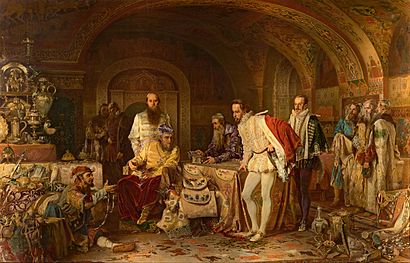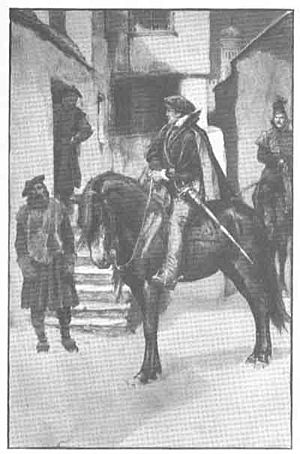Jerome Horsey facts for kids
Sir Jerome Horsey (born around 1550, died 1626) was an English explorer, diplomat, and politician. He lived during the 16th and 17th centuries.
Jerome Horsey spent about seventeen years in Russia. He first arrived in 1573 and left in 1591. During this time, he met many important people at the Russian royal court. He first went to Moscow to work for the Russia Company, which was a trading company. Later, he became a special messenger, or envoy. He carried messages from Tsar Ivan the Terrible to Queen Elizabeth of England. He also carried messages from Queen Elizabeth back to Tsar Ivan.
After returning to England, Horsey became a member of the House of Commons. This is part of the English government. He worked on many important groups there. In 1603, he was made a knight. He wrote down his experiences in Russia, and these stories have been published many times.
Contents
Jerome Horsey's Life and Adventures
Early Life and Family
Jerome Horsey's father was William Horsey, a merchant from Exeter. His mother was Elinor Peryam. Jerome's grandfather was Sir John Horsey II. His uncle, Sir Edward Horsey, was in charge of the Isle of Wight before the Spanish Armada arrived.
Jerome Horsey likely married three times. His first wife was Elizabeth Hampden, whom he married in 1592. They had two sons and three daughters. Elizabeth passed away in 1607. He then married Isabella Brocket around 1609.
First Trip to Russia
Horsey started working for the Russia Company in 1571. This company traded goods with Russia. He first went to Russia in May 1573. He worked as an interpreter, helping people understand different languages.
On his way to Moscow, he helped save the town of Kostroma from the Tsar. Because of this, the people of Kostroma gave him gold and jewels. The Russia Company later asked Horsey to get a new trading agreement for them. They also wanted more land for the English trading area in Moscow. This area is still on Varvarka Street today. Horsey even had his own house there, where he hosted Russian noblemen.
Helping Others in Moscow
Horsey said he helped many German prisoners who were captured. Merchants from Hamburg and Lübeck gave him gifts for his help. He also became friends with about 1200 Scottish and English prisoners in Moscow. He helped them find jobs in the Russian Army. He even got permission for them to build a church.
While in Moscow, Horsey also did some private trading. He traded for important English people like Leicester and Walsingham. This was against the rules of the Russia Company. Later, he had a disagreement with the company about this. But in the end, they found that the company actually owed him money.
Working with Russian Tsars

Horsey spent a lot of time at the Russian royal court. Tsar Ivan invited him to see the royal treasury. Horsey also attended the crowning of the next Tsar, Tsar Theodore. The Russian court had many disagreements. Horsey said that Vasily Shchelkanov was his "worst enemy," but Boris Godunov was his friend.
Horsey also became friends with Princess Maria Vladimirovna. She was first married to Magnus the Dane. After Magnus died, Boris Godunov asked Horsey to convince Maria to return to Russia. However, she was then held captive. Horsey wanted to marry Maria, but he was not allowed to because he was not a nobleman. Maria was later sent to live in a nunnery.
Important Journeys
In late 1581, Tsar Ivan asked Horsey to take secret letters to Queen Elizabeth. The letters were hidden in a flask. Horsey had to travel by land because the sea was frozen. This journey was very difficult. He was even arrested on the Danish island of Oesel. Luckily, the governor's wife, Madelyn van Uxel, was someone Horsey had helped before. Horsey also met Princess Maria again during this trip.
Second Visit to Russia
When Horsey arrived in London, he met with Queen Elizabeth many times. He translated the secret papers he had carried. Horsey then returned to Russia with nine ships full of goods. Some of these goods were from other adventurers, not just the Russia Company.
He later went back to England with letters from the Tsar. The Tsar's wife was having trouble having children and needed help. However, the message was misunderstood. Jerome returned with a midwife, which did not make the Russian court happy. At this time, the English also lost favor in Russia. The Russians thought that the Spanish would conquer England. But when the Russians learned that the Spanish Armada was defeated, the English got half of their customs duty removed.
Horsey returned to England again in 1587. He had seemingly agreed with Boris Godunov that he would marry Maria when he came back. After this, Horsey was accused of cheating. But his friends at the English court supported him. He was asked to return to Russia in 1591. However, the Tsar refused to see him. The Tsar asked Queen Elizabeth never to let Horsey come to Russia again. He was called "a well known spy." Boris Godunov helped him travel back to England and gave him a large gift of money.
Back in England
In 1595, Horsey was accused of a very serious crime called high treason. This accusation came from a man named Finch. It is thought that Finch was put up to this by Sir Jeremy Bowes, who was a former ambassador to Moscow. Bowes believed Horsey had caused him to be sent home from Russia. The Queen had to sign a paper for Horsey's arrest. But she said, "I still believe Jerome Horsey will prove himself honest." The case went to the Privy Council in April 1597. The case was dismissed, and Finch was proven to be a liar.
Horsey worked for the Russia Company from 1572 to about 1585. In 1580, he became an Esquire of the Body to Queen Elizabeth. This was an important position in the royal household. He was made a knight on July 23, 1603. In 1604, he became responsible for Crown Lands in nine counties. He was also a Justice of the Peace in Buckinghamshire from about 1601. This meant he helped keep law and order. He was the High Sheriff of Buckinghamshire in 1611–12.
Horsey served in the Parliament for over 30 years. He represented different places like Saltash (1593), Camelford (1597), Bossiney (1601, 1604, and 1614), and East Looe (1621). He also translated the Slavonic Bible. He is known for introducing the term "White Russia" into England, which is now known as Belarus.
Sir Jerome Horsey passed away in January 1626 and was buried at Great Kimble. His writings are sometimes used by historians to learn about Eastern Europe, Russia, and the time of Ivan the Terrible.


